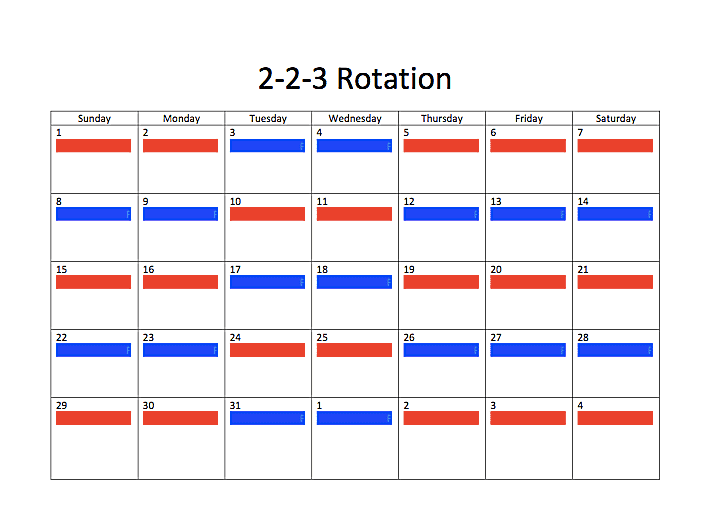The swing shift is a team of workers who cover the regular shifts in a factory seven days a week as needed to give them one or more days off per week. The work shift between the day and night shifts (from 4 p.m. to midnight).
Those who work the swing shift typically need to go to bed later than other members of the community because their shifts end in the late evening. Because the rest of society typically runs on a nine to five schedule, assuming that people are at work between nine in the morning and five in the afternoon, they might have trouble scheduling things like social events, medical appointments, and so forth. Swing shift workers may have particularly serious issues with things like childcare.
Read on for more information about what a swing shift is, which I will illustrate in more detail in the post.
Table of Contents
Swing Shift Description
When a worker works varying hours throughout the day and night, it is known as a swing shift. Rather than reporting to work at the customary 9 a.m. to 5 p.m. workday, you may work from 12 p.m. to 8 p.m. one day, 9 a.m. to 5 p.m. the next day, and 8 p.m. to 4 a.m. after that. The majority of businesses that need continuous operations day and night use swing shift schedules. Swing shift hours are necessary for businesses to maintain consistent productivity throughout the day and night and to ensure that services are available to satisfy the needs of their customers.
Every swing shift schedule will be different, and some employers may give you the option of selecting from a variety of shifts or offering flexibility so you can select specific shifts on specific days to accommodate your obligations at home and elsewhere. Some individuals find swing shifts to be extremely convenient, and some even prefer to work hours that are not part of the typical workday.
Read about: What Is A Split Shift?
How Does a Swing Shift Work?
The specifics of each organization’s swing shift schedule will vary, but the majority of businesses typically provide the following shift schedules:
- Eight-hour shifts that are either fixed or rotating and are either in the morning, evening, or overnight
- Four consecutive 10-hour shifts with three days off after the four days are completed
- 12-hour shifts with several days off after each shift
Additionally, there are numerous variations on swing shifts, such as:
- Afternoon shifts: This describes a shift where workers start at around three in the afternoon. and work until midnight.
- First shift: In most cases, this shift corresponds to earlier, more conventional business hours, like 8 or 9 a.m. to 5 p.m.
- Second shift: This shift, which starts around 3 or 4 p.m., is comparable to the afternoon shift.
- Third shift: When the second shift ends, this shift starts. This means that if the second shift ends at 10 p.m., the third shift will begin at 10 p.m. and end around 6 a.m.
- Fixed shift: Employees who work this type of shift adhere to the same schedule. For instance, a worker might always work the first shift.
- Split shift: When two shifts are broken up into one day, it is referred to as a split shift. For instance, a worker might start at 8 am. to 2 p.m. and then work again from 6 p.m. to midnight.
The majority of workers will get their swing shift schedules ahead of time so they can plan their days appropriately to accommodate their hours. Some employees have a set swing shift schedule, whereas others might have a weekly or monthly schedule change.
Read about: What Is A 2-2-3 Schedule

Pros & Cons Of Swing Shift Hours
For many businesses, swing shift hours are essential. It’s more complicated than that, so they can’t just tell everyone to arrive at 9 AM and leave at 5 PM.
Swing shift management can be a little trickier, but that doesn’t mean you can’t succeed at it.
In order to make your shift patterns effective, let’s examine the benefits and drawbacks of swing shifts from both the viewpoints of management and employees.
Employees
Swing shifts are largely dependent on employee convenience. When planned properly, they can provide people with a balanced schedule, but when decisions are made at the last minute and schedules are frequently altered, they can be a major source of aggravation.
Pros
- Most peoples’ lives don’t neatly fit into a 9-to-5 schedule
- Swing shifts allow you to be more flexible
- They offer variety — you get to do slightly different work with different people
- Can offer better pay with additional perks
Cons
- Less certainty
- Schedules can change at short notice
- Working when everyone else is off
- Can be long, tiring shifts
- Hard to find someone to cover your shift
Management
Swing shifts give management a lot of flexibility as well. Instead of having all of their employees work at the same time, they enable businesses to ensure that the right mix of skills is employed at all times.
Pros
- Your business can stay open longer to reflect the needs of your clients
- Combine different skill sets as needed
Cons
- Impact on employee’s health
- Less certainty — more confusion on shift timing
- Difficult manage balance schedule of each employee
- Hard to manage shift cover request
Read about: What Is A 9/80 Schedule?
Normal Swing Shift Hours
Swing shift hours vary from company to company, but there are some typical patterns you’re likely to observe. The main benefit of swing shifts is that they take into account the demands of your company.
In fields where work must be done round-the-clock, swing shifts are frequently used. Making sure you’re managing your employees’ shifts to prevent burnout is especially crucial if your business is open around-the-clock.
In the following sectors, you frequently see this:
- Hospitality
- Retail
- Health Care
- Transportation
- Customer Service
- Public Safety
Swing shifts can be used in any business, even though these may be the ones that employ them most frequently. When done correctly, this can raise output to new heights while also improving the working environment.
Here are some typical swing shift patterns and hours to help you get a sense of how a swing shift schedule might work for your company.
Swing shift patterns:
- Eight-hour shifts: either fixed (eg 12-8 Monday through Friday) or varied (eg morning shift Monday, Wednesday, Friday, afternoon shift on Tuesdays and Thursdays)
- Ten-hour shifts: four days on, three days off.
- Twelve-hour shifts: Multiple days off, one day on.
Swing shift hours:
- Afternoon shift: employees begin work in the afternoon, working from around 3 PM to midnight.
- First shift: Employees will typically work from 9 AM to 5 PM on the first shift, which is similar to regular business hours.
- Second shift: With a typical start time of 3 or 4 PM, the second shift is comparable to the afternoon shift.
- Third shift: After the second shift is finished, the third shift typically takes over. The third shift would start at midnight if the second shift ended then.
- Fixed shift: Here, a worker’s schedule is set. They might put in five days a week on the second shift.
- Split shift: Employees work two shorter shifts in a day when working a split shift. They might work from 8 am to noon and then from 6 pm to 10 pm, for instance.
It seems like there would be a lot of scheduling to do. It’s not required to be! With ZoomShift, you can easily create swing shift schedules for all of your employees on a single platform.
Editor’s pick: How long will it take me to get to work really? How to cut commuting time? Click here!
Normal Industries That Use Swing Shifts
In professions where the business must run continuously, sometimes 24 hours a day, shift work is common. Evening hours are observed by some businesses, such as eateries and shops. Having staff on duty at night is crucial for other businesses like hospitals or manufacturing facilities. There are some businesses that mandate early morning hours. businesses engaged in agriculture or construction, for instance. The following is a list of the more typical professions that demand swing shifts:
Healthcare

For patients who require immediate care or who spend the night in hospitals, employees in the healthcare sector work swing shift hours. They are able to work overnight or in the morning. Depending on the quantity of patients, a certain number of medical personnel must typically be on duty. The hospital may also need administrative staff members to check in patients after regular business hours. To keep the area sterile, cleaning staff may also be employed during these times.
Read about: What Is A Caretaker?
Public Health And Safety

Employees in public safety put in swing shift hours to assist the general public in case of an emergency. A policeman, paramedic, or firefighter may be needed in an emergency to help people who are in danger. Technical experts such as an electrician who fixes a downed power pole during a storm are another example of what it can mean.
Retail

Swing shift employment is necessary in the retail industry to keep up with online competitors’ demand for goods. For instance, supermarkets employ swing shift workers to stock shelves with goods that customers can purchase the following day. Numerous stores stay open late.
Hospitality

Swing-shift workers are frequently hired by the hospitality sector. Employees in the hospitality sector are typically expected to serve customers at various times throughout the day and night. Employees who prepare, serve, and clean dishes may work in shifts in hotels and restaurants, for instance.
Customer Service

Outside of regular business hours, many companies provide customer service. For instance, some call centers are open late so that clients can speak with someone about a concern or solve a issue whenever it’s convenient for them. To accommodate customers who follow more conventional schedules, these businesses might offer swing shifts.
Perform Shift Work Tips
Here are some pointers for working a swing shift successfully:
Rethink Your Sleep Patterns
You may be encouraged to change your sleep schedule to fit your work schedule if you work swing shifts. Consider experimenting with segmented sleep, which enables you to get eight hours of sleep overall but not all at once. For instance, if your shift ends at 2 a.m., make an effort to sleep. By using this technique, you can sleep for five hours in the morning and an additional three hours before work. Your body is consequently getting enough sleep, but it’s sleeping in a way that fits with your schedule.
Create A Routine Where Possible
You’re better off mentally if you follow a routine. A routine creates security and helps your brain anticipate what will happen next. Making a schedule that takes into account your shifts can help because shift work can disrupt regular routines. You can feel more organized and have better sleep if you have a pre-shift pattern where you have tasks to finish before you leave for work or a bedtime routine where you pack your lunch and get dressed for the next day.
Maintain A Close Relationship With Friends And Family
Give yourself some time to visit local relatives and friends. The next time you want to visit friends or relatives who are employed during regular business hours, think about scheduling time off during the week or on the weekend. If your friends reside in a different city or state, video calls may be beneficial. You can also schedule a time when you are both available by swapping shifts with acquaintances who also work swing shifts.
Keep To A 24-hour Clock
If you don’t have access to natural light, a 24-hour clock rather than a 12-hour clock can help you keep track of the night and day. Additionally, it can aid in the development of a unique schedule for both your professional and personal lives. The setting on a digital clock or the use of an analog watch are two options.
Set Time For Exercise
Exercise is crucial for living a healthy lifestyle and can support your energy levels. Consider how you can make exercise a priority and fit it into your schedule. In order to accommodate people who work different hours, many gyms are now open 24/7. Alternately, benefit from the many free exercise videos that are available online. If you are working hard, you might think about going for a short stroll around your neighborhood.
Look After Your Body
Eat a balanced, healthy diet before your shift that is rich in fruit, vegetables, protein, and carbohydrates if you want to maintain a high level of energy for the duration of your shift work. Bring along plenty of wholesome snacks from home so you won’t be tempted to eat unhealthy food while working. To reduce the quantity of snacks you purchase at work, you might also think about bringing little cash and leaving your debit or credit cards at home.

Stay Hydrated
To avoid becoming dehydrated at work and to increase productivity, bring a large bottle of water, flavor-infused water, or juice. You can stay alert throughout your shift by drinking plenty of water. A great way to stay hydrated is to consume fruit and ice cream.
Understand Rights
In order to protect employees, many industries have established laws and regulations. Each state has a minimum and maximum number of hours that employees may work in a shift. By working extra hours or extending current shifts, your employer may offer paid overtime. To decide on an appropriate number of additional hours, think about speaking with your HR department.
See more about: Accommodate Everyone Schedule Meaning. Ensure that the funds are sufficient to cover everyone’s needs. to give someone a place to dwell or stay…
FAQs
Swing Shift Pay
Depending on the employer you work for, you may be paid differently for working swing shift hours. You could put in an eight-hour shift and be paid the same as a worker who works during regular business hours.
The work you do outside of shift hours may be compensated hourly for swing shift workers who are on-call. Your shift might be longer than eight hours at your employer’s request. To ensure that you work in a secure environment and that your compensation is fair, employers must abide by labor laws.
What is the Purpose of Swing Shift?
Swing shift hours streamline the operations of a business because they can continue working after the completion of business hours. The reason why businesses provide these hours is so they can boost productivity and meet customer needs. The time of day you work may change if your manager changes your schedule.
What is a 12-hour Swing Shift?
It might function in a rotating 12-hour shift. For three days you work 12 hours during the day, have two days off; work 12 hours on nights for 4 days, have 3 days off; work 12 hours on days for 3 days etc. It goes without saying that this theme has many variations.
What is a Swing Shift in Nursing?
Nursing staff members can either work the day or the night shift. The swing-shift nurses are a completely different group that works both day and night. Working swing shifts—day shifts and night shifts in the same week or even in two-week period—can be tough on your body.
What is a Swing Shift in a Restaurant?
In a restaurant, a swing shift schedule is a scheduling method that sees some employees working irregular or rotating shifts throughout the week to ensure proper staffing at all times. Simply put, it’s a term for workers who report for duty at various times throughout the week.
Graveyard Vs Swing Shift
Swing shift hours streamline the operations of a business because they can continue working after the completion of business hours. The reason why businesses provide these hours is so they can boost productivity and meet customer needs. Your schedule may be changed by your manager, which could affect what time of day you work.
Final Thoughts
The post focused on what a swing shift is.
Not everyone should work the swing shift. When school activities, community programs, or sporting events are over in the afternoon, families with young children may struggle to find child care. Some people may not be able to afford the cost of hiring a babysitter or nanny. Concerning oneself with one’s children can cause workers to become distracted, which reduces productivity.
Please leave a comment if you have any questions about what a swing shift is. As long as I see it, I will respond right away.
Thank you so much for reading. Thank you!



